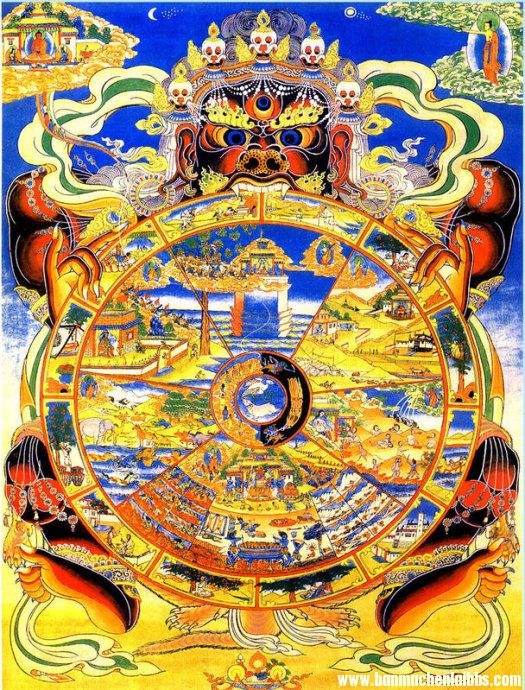
Wheel of life
The above is the basic view of the universe of Buddhism. It tells about the truth of the world that we are living and the world we have been or will be in and how and why. What is stated below is the illustration and explanation to the above picture (it is called Tangka in Buddhism).
The Twelve Interdependent Causes and their Effects
-The outer rim of the wheel is the depiction of the “Twelve Interdependent Causes and their Effects”
(Starting clockwise from top right)
1.The first depiction is of a blind old man with his stick unable to find his way. This represents spiritual blindness and ignorance
2. This picture shows a potter whose pots symbolize his own deeds (thinking, speaking, and acting) with these he moulds his own karma (fate).
3. A monkey is shown in a tree springing from branch to branch which symbolizes the major consciousness which ignorant people spring uncontrolled from object to object.
4. A boat is show with two people which symbolizes name and form, spiritual and physical energy, inseparably floating on the stream of life.
5. A house with five windows and a door. The five windows symbolize the five senses and the door symbolizes the faculty of thought. These are the things by which the outer world is perceived.
6. A man and a woman embracing symbolizing the consequence of sensual perceptions.
7. This picture shows the emotions by which one is stuck like an arrow to the eye.
8. A woman offering a drink to man represents desire (falling in love), stimulation by perception and emotion which leads to a “thirst for life”.
9. A man is shown picking the fruits from a tree which represents “sensual entanglement” which is the longing to keep what is desired.
10. Procreation is depicted through the illustration of a man and wife sleeping together in a tent symbolizing becoming or existence.
11. The consequence of the previous picture is shown through the depiction of a woman giving birth to a child symbolizing birth.
12. The illustration of inevitable old age(decay) and death in earthly existences symbolized through the depiction of the Tibetan tradition of feeding a corpse to the vultures.
The Symbolic Six Worlds
-The areas between the six spokes represent the six forms of unenlightened existence.
(Starting clockwise from top)
1. Abode of the Gods: a temporary paradise achieved by the action of good deeds. Buddha is illustrated in the top right section with a dramnyen (lute) reminding the gods of their limited pleasures and guarding them against vanity and arrogance which deceives them into believing themselves to be everlasting. However these gods are not free from suffering, after thousands of human years, they are too are subject to old age and death. Thus their suffering is the illusion of eternity in their state of paradise. Their suffering lies in the eventual realization of this error.
2.The World of Men: driven by egoism and ignorance they suffer from the permanent repeated cycle of birth, sickness and death
3.The Realm of the Insatiable: Greedy ghosts suffer from hunger and thirst which they cannot appease or quench. They are depicted with tightened throats and bloated bellies. Buddha is also depicted with a jar of nectar for the hungry ghosts.
4. The World of Hells: There is a cold and hot hell. They are a place of torture for those who have committed evil deeds out of hatred and anger. This life is not eternal however, after being punished for their sins, rebirth into a better life is possible. Yama, the Lord of Death weighs the deeds of the deceased who enter into his kingdom, but he does not decide their fate since their fate has already been decided by themselves. The Buddha is depicted in the top left bringing light and hope to those even in the darkest region.
5. The World of Animals: They suffer from oppression by other beings and they devour each other and become “beasts of burden”
6. The World of the Titans: The titans are permanently warring against the gods and fighting for the fulfillment of their desires. They suffer due to the endless war and the result of envy and insatiable ambition.
The White Path
(Shown in the right of the ring surrounding the very center circle)
-This is the “Path of Bliss” which leads to better rebirths and towards a final liberation. Saints and sages are shown leading the virtuous along the path.
The Dark Path
(Shown in the left of the ring surrounding the very center circle)
-This is the path where the ignorant and sinners are dragged along by demons armed with nooses. This is the path for those who engage in ignorance, envy and hatred, and greed. This path leads to hells and bad rebirths.
The Roots of Evil
(Shown at the very center of the wheel)
-The force that drives the wheel from its hub. Depicted are 3 symbolic animals known as the “Three Unwholesome Roots” because from them grow all the evils of life, or as the “Three Poisons” because they corrupt from within. The cock represents greed, the snake hatred and the pig ignorance, and these are the three things that create all human bondage and misery.
Buddha
(Shown at the very top right of the illustration)
-Buddha is shown representing the potential nirvana possible for all living beings. Nirvana is also possible for all of the beings depicted in the wheel of life.
Bodhisattava
(Shown at the very top left of the illustration)
-The Bodhisattava of compassion looks down in compassion. He is saddened for those suffering in all the six realms. The Bodhisattava is the link between the mundane and the transcendental. He represents the drive within the ordinary to fulfill the transcendental. This link is depicted, if you look closely you can see a discrete line drawn from the top of the “White Path” leading to Buddha representing those beings attaining nirvana. |